
The Tortricidae are a family of moths, commonly known as tortrix moths or leafroller moths, in the order Lepidoptera. This large family has over 11,000 species described, and is the sole member of the superfamily Tortricoidea, although the genus Heliocosma is sometimes placed within this superfamily. Many of these are economically important pests. Olethreutidae is a junior synonym. The typical resting posture is with the wings folded back, producing a rather rounded profile.

Crambidae comprises the grass moth family of lepidopterans. They are variable in appearance, with the nominal subfamily Crambinae taking up closely folded postures on grass stems where they are inconspicuous, while other subfamilies include brightly coloured and patterned insects that rest in wing-spread attitudes.
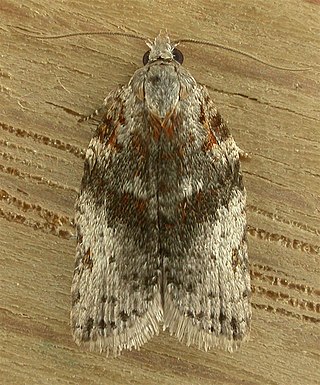
Isotenes miserana is a species of moth of the family Tortricidae. It is found in the Northern Territory, Queensland, New South Wales and Victoria. This species has been introduced to New Zealand.

Acleris semipurpurana is a species in the moth family Tortricidae, and one of several species of moth commonly known as oak leaftier or oak leaf tier. The larvae feed on the leaves of oak trees in the Eastern United States and southeastern Canada which can be a major cause of defoliation. The loss of leaves can kill or damage the affected trees, which are chiefly in the Lobatae or red oak section of Quercus, or oaks.

Archips semiferanus is a species of moth in the family Tortricidae, and one of several species of moth commonly known as oak leafroller or oak leaf roller. The larvae feed on the leaves of oak trees in the eastern United States and southeastern Canada and are a major defoliator of oak trees, which can lead to tree mortality. In Pennsylvania in the late 1960s and early 1970s, oak leafrollers defoliated over 1,045,000 acres (423,000 ha).

Ochetarcha is a genus of moths belonging to the subfamily Tortricinae of the family Tortricidae. It contains only one described species, Ochetarcha miraculosa, also known as the ponga stem borer, which is found in New Zealand.

Hystrichophora is a genus of moths belonging to the family Tortricidae.

Cryptophlebia ombrodelta, the litchi fruit moth or macadamia nut borer, is a moth of the family Tortricidae. The species was first described by Oswald Bertram Lower in 1898. It is native to India, Sri Lanka, Nepal, Indonesia, China, Taiwan, Vietnam, Thailand, western Malaysia, New Guinea, the Philippines, Japan, Guam, the Caroline Islands, Australia and has been introduced to Hawaii.

The Enarmoniini are a tribe of tortrix moths.

Proteoteras aesculana, the maple twig borer, early proteoteras or maple tip moth, is a moth of the family Tortricidae. It is found from coast to coast in the northern United States, south to Mississippi in the east and to California in the west. It has a scattered distribution in Canada, from Nova Scotia to southern Alberta.

Bactra venosana, the nutgrass borer or nutsedge borer, is a moth of the family Tortricidae. It was first described by Philipp Christoph Zeller in 1847. Julius von Kennel provides a full description. It has a wide distribution, from southern Europe, North Africa and Asia Minor to India, Sri Lanka, southern China, Malaya, Australia and into the Pacific where it is found on Java, Borneo, the Philippines, Taiwan, Timor, the Solomons, the Carolines and Fiji. It was introduced to Hawaii in 1925 to control nutsedge. It is now found on Kauai, Oahu, Molokai, Maui, Lanai and Hawaii.

Cryptophlebia illepida is a species of moth in the family Tortricidae that is endemic to the islands of Kauaʻi, Oʻahu, Molokaʻi, Maui, Lānaʻi and Hawaiʻi. Common names include koa seedworm, klu tortricid, koa seed moth, litchi borer, litchi moth, macadamia nut borer and macadamia nut moth. It was first described by Arthur Gardiner Butler in 1882.

Tirathaba rufivena, the coconut spike moth, greater coconut spike moth or oil palm bunch moth, is a moth of the family Pyralidae. It is found from south-east Asia to the Pacific islands, including Malaysia, the Cook Islands, the Philippines and the tropical region of Queensland, Australia. They are considered as a minor pest.

Eucopina tocullionana, the white pine cone borer, is a moth of the family Tortricidae. It is found in North America from Minnesota to Quebec, south in the Appalachian Mountains to northern Georgia.
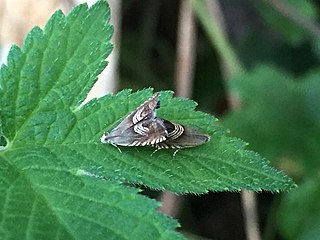
Grapholita delineana, known generally as Eurasian hemp moth, is a species of tortricid moth in the family Tortricidae. Other common names include the hemp moth and hemp borer.
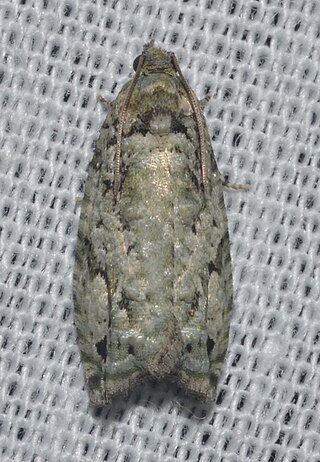
Proteoteras moffatiana, known generally as the gray-flanked proteotera or maple shoot borer, is a species of tortricid moth in the family Tortricidae.
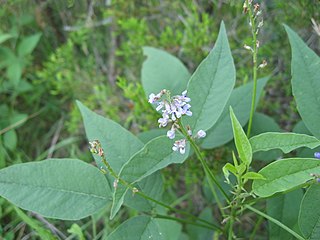
Orbexilum onobrychis, commonly called French-grass or lanceleaf scurfpea, is a species of flowering plant in the legume family (Fabaceae). It is native to the eastern United States where its range is concentrated in the Midwest and Upper South. Its natural habitat is primarily prairies and riverbanks, typically in mesic or wet areas. It is an uncommon species, and can be found in high-quality prairie remnants as well as more disturbed areas.

Eucopina is a genus of tortricid moths in the family Tortricidae found in North America. There are about nine described species in Eucopina.
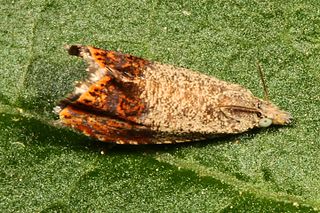
Talponia plummeriana, the speckled talponia moth or pawpaw peduncle borer, is a moth of the family Tortricidae. It is native to the southeastern United States.




















